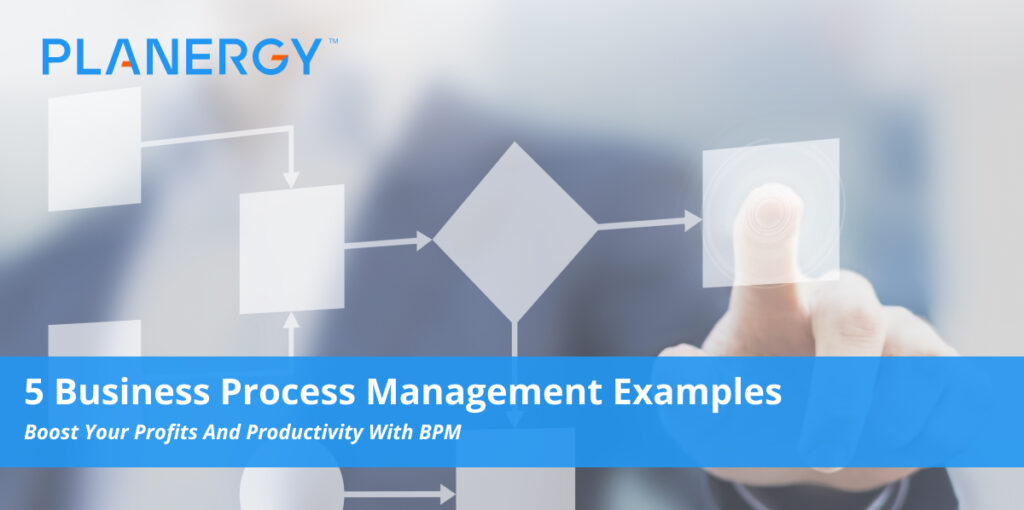While there’s something to be said for hard work, technological prowess, and good old-fashioned luck, the true heart of every thriving business is constructed from a commitment not just to excellence, but to improving upon that excellence for even greater success.
Business process management, or BPM, is the system your company uses to manage, refine, and ultimately optimize the processes that drive everything from production to procurement.
Used effectively, it can help you trim waste, streamline workflows, and get the biggest return on investment (ROI) possible for every dollar spent.
But effective BPM doesn’t just happen on its own. To get the most from your business process management in the age of digital transformation, you need both the right technological tools and a clear understanding of how BPM works and the many ways it can help you develop and implement business processes that help your company thrive.
Business Process Management vs Project and Task Management
Every business process, from the simplest to the most complex, can be broken down into a set of activities that can be readily repeated on demand.
Every department, business unit, and division of your company relies on numerous business processes to complete their daily tasks and pursue short- and long-term goals that support your company’s overall strategies for profitability, growth, and innovation.
It’s common to conflate or confuse business processes with projects or tasks, but they are distinct from either of these terms in important ways:
- A process is a set of documented steps that can be repeated as required to accomplish a specific goal. Processes are ongoing and can often be applied to one or more different workflows that share similar internal tasks with minimal modification.
- A project also uses a defined number of steps to achieve specific goals, but is usually not repeatable. (e.g., developing an SEO strategy for a customer). Projects are subjective, unique, and original.
- A task is a subset of a process or project. It contains a defined number of steps that may depend on the completion of other tasks to be considered complete. Any given process or project will likely be made up of several distinct tasks.
No two businesses will implement identical BPM tools or strategies, but in general the BPM lifecycle is itself a readily documented and implemented process that can be broken into five distinct stages:
- Business Process Modeling/Mapping. What steps are required to complete the process successfully? What benchmarks and other factors must be met for completion to be considered successful?
- Process Analysis. What roadblocks, inefficiencies, and errors occur?
- Process Design/Refinement. What improvements can be made to address the problems identified in step 2?
- Process Review. The new process is rolled out on a limited basis for review. How does it perform? Are further adjustments required?
- Implementation. Once the process meets requirements, it is rolled out across the organization.
Whatever your company’s organizational goals are, business process management directly supports their completion through greater productivity and efficiency, as well as the elimination of inefficiencies and waste.
The Benefits of Business Process Management
The primary goal of business process management is to leverage workflow management tools such as business process modeling, business process mapping, process design, and process automation in tandem with information technology (IT) and BPM software to achieve maximum possible ROI.
In doing so, BPM also supports organizational goals and, in many cases, plays an essential role in achieving digital transformation.
Depending on the business, the desired goals might include:
- Greater customer satisfaction
- Elimination of ongoing compliance issues
- Improved decision making to drive more effective business strategy
- Improved competitive performance
- Developing a corporate culture focused on innovation and shared success
Whatever your company’s organizational goals are, business process management directly supports their completion through greater productivity and efficiency, as well as the elimination of inefficiencies and waste.
Business Process Management in Action
Every part of the BPM lifecycle, from process mapping to implementation, can be achieved more quickly, effectively, and accurately with the right BPM tools—the most important of which is the BPM software you choose.
A comprehensive software solution with a built-in BPM suite, such as PLANERGY, can help you manage and streamline even the most complex business processes, including the entirety of your procure-to-pay (P2P) cycle.
Cloud-based convenience and mobile-friendly, role-appropriate access work together to promote collaboration and communication, rather than confusion and competition.
Robust and intuitive business process automation, along with advanced analytical tools, means you can quickly analyze, modify, test, and tweak all your existing business processes for optimal efficiency and performance.
In addition to re-engineering your current workflows, you can also develop new processes to eliminate outmoded manual workflows and replace error-riddled pen and paper with sleek, reliable digital performance.
Consider how business process management improves processes that are commonly considered to be productivity pain points with manual processes:
1. Purchase Approvals
For many businesses, the purchase approval process is haunted by a trio of costly spectres that sap efficiency and productivity:
- Rogue spend (maverick spend), which occurs when staff have few or no formal purchasing processes in place to prevent them from buying goods and services from non-approved or sub-optimal suppliers. Such spend is often “invisible” since these purchases may or may not enter the official procurement and accounts payable systems. As a result, everything from cash flow to budgets to financial reports and forecasts are skewed.
- Human error, ranging from data entry errors to lost paperwork to routing errors.
- Lack of transparency. With manual, paper-based workflows, approvals can linger in unattended mailboxes, awaiting the proper approver to return from vacation, or get lost in the shuffle between departments. In the meantime, delays can cause critical shortages of essential production goods, cost your company valuable discounts on shipping, or create additional expenses via rush order fees if and when the approval form ever makes its way to the end of the workflow.
A BPM solution helps exorcise these dark spirits through full spend transparency and process automation.
A closed buying environment, stocked with pre-approved vendors with the best terms, conditions, and prices for all the goods and services you use, helps prevent maverick spend.
Built-in reminders, tracking, and contingencies makes it much easier to track approvals and ensure they’re signed in time to capture discounts and promotions—and keep your production humming.
Process automation takes the human factor out of data entry, automatically storing essential product and vendor information to populate forms with just a few clicks.
2. Invoice Processing
Like approvals, invoice processing can be a potential minefield of needless expense and inefficiency.
- Fraud is the darker sibling of maverick spend. Without full spend visibility, it’s all too easy for opportunistic scammers to submit invoices that get paid without any matching documentation, or, even more regrettably, staff to become thieves by gaming the system.
- Human error, again related to data entry and routing errors, as well as invoice exceptions.
- Process inefficiencies. Without an easy way to track or verify invoices, they could linger in your system so long that you’re on the hook for late fees and penalties instead of enjoying early payment discounts. Slow payment can damage otherwise strong relationships with key vendors, making it difficult to get the best terms and pricing.
With BPM software, you can develop automated workflows that eliminate delays, fraud, and errors while improving accuracy.
Faster invoice processing times means greater overall efficiency, and faster payments for your vendors.
You’ll capture more discounts, improve your vendor relationships, and avoid falling victim to scams.
3. Supplier Management
Is your supply chain as efficient and lean as it could be? Are you struggling to find the right vendors to ensure consistent and reliable delivery of essential goods and services at a fair price?
Are you concerned about additional risk exposure created by suppliers whose own lack of effective BPM may lead to unsafe working conditions, questionable social responsibility, or legal violations?
Building effective supplier management into your BPM strategy can help insulate you from these potential problems by connecting your vendors with your system through a vendor portal, where you can effectively evaluate existing vendors and onboard new ones that meet your operational, compliance, and pricing requirements.
You can also create strong relationships with your most trusted vendors while creating contingencies that ensure you’re insulated against unforeseen disasters when you incorporate vendor risk management (VRM) into your business process management.
4. Contract Management
Manually confirming contract compliance is costly, time-consuming, and prone to human error, as is having to chase down the latest version of a contract between your company and a given vendor every time you need to generate a purchase order.
Cloud-based and centralized data management, along with a dedicated contract management module designed to work seamlessly with your BPM suite, can eliminate these headaches.
Automated workflows for contract creation (including pre-approved boilerplate from your legal team) makes it easier to onboard new vendors or revise contracts with existing ones.
Automatic population of relevant contract terms, conditions, and pricing ensures you never pay more for goods and services than you should, and never miss out on special purchasing opportunities your team negotiated before signing—or overlook compliance issues created by vendors.
5. Business Strategy
Decision making is only as good as the data that supports it.
Connecting all of your workflows, centralizing your data management, and creating a culture of collaboration and communication through BPM is crucial when navigating the cutthroat environs of the modern business world.
The innumerable streams feeding this sea of Big Data let companies who leverage BPM to connect disparate data sources—including spend data, internal performance and efficiency, and external data such as customer buying behavior, market research, and vendor performance/compliance data—and analyze them to reveal internal process improvements, strategic opportunities for partnerships and market expansion, potential cost savings from contract renegotiations, and more.
Deep analysis provides actionable insights that lead to further improvements, and the foundation for the next iteration of potential refinements that lies beyond.
As a result, continuous improvement becomes not just a buzzword but a habit at all levels of your organization.
BPM Drives Bigger Profits and Greater Efficiency
There’s no need to let outdated tech or inefficient workflows rob your company of an optimal ROI.
Trimming waste and inefficiencies from your business processes by automating and optimizing your workflows can help you achieve not just greater profits, but less risk and more innovation.
Invest in business process management software and ensure every move your company makes is generating a return that feeds your growth and success.




